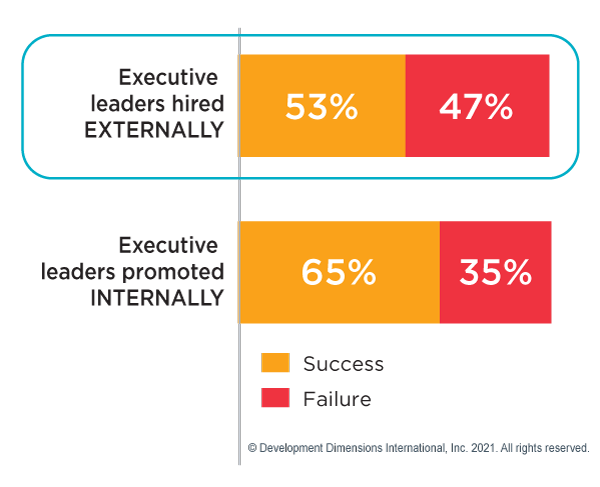The challenges of middle management are a lot like a game many of us have played: piggy in the middle. A friend on one side, a friend on the other side, and a ball flying up and over your head. This is the dance of the middle manager—executive leadership on one side and their frontline leadership teams on the other.
The thing you might recall about being piggy in the middle? It feels lonely. It seems somewhat impossible to succeed. Middle managers need a stepladder to help them be successful, but they are often abandoned and poorly prepared.
Expectations of Middle Management Leadership Roles
Middle management encompasses a broad group of leaders with widely varying responsibilities and complex development needs. Common job titles include general managers, directors, and supervisors—anyone responsible for leading other leaders or who is positioned between top-level executives and frontline leaders.
It may be tempting to confine the role of a middle manager to performance reviewer or task manager, but they’re much more than that. Mid-level managers are quite literally in the middle of an organization, a crucial connection point. Their goal is to get control of what flows between executive and frontline leadership: how strategy translates into execution; how practical organizational ambitions become workplace culture; how aggressive growth targets lead to productivity and innovation.
On the surface, the roles and challenges of middle management look simple: break down strategic goals into specific actions, and then drive those actions to completion. Practically, these leaders are prepared. As successful frontline managers, they were likely promoted because of their ability to solve problems, drive results, and achieve through others. But in reality, many middle managers find themselves unprepared for the real work that needs to be done, influencing and communicating up and down to move initiatives forward. They are caught in the middle without immediate control over strategy or direct oversight over execution. So, what’s a middle manager to do?
Challenges Middle Managers Face and Key Skills Needed for Success
Interaction leadership skills become significantly more important. At the front line, you set a tone on a small team, but now the middle manager’s shadow casts over a function, unit, or country's operation. Middle managers play a critical role in driving ethical company culture. Here are a few of the must-have skills middle managers need with examples of how strengths and weaknesses in these areas have affected clients that I’ve spoken with in research gathering and coaching sessions:
1. Conflict management
Piggy in the middle is usually a game played with friends. But what if it’s not a friendly game? I recently spoke with a director who became the leader of an acquired business in Western Europe. The CEO of the business reports to the director but isn’t happy about it. In fact, the CEO is pretty much continuing to run their business in a vacuum and failing to partner with the leaders of other regional businesses.
A direct report of the director recently declared, “I know we need to get him on board with the wider vision, but I just can’t be bothered to try and engage him anymore. He’s a nightmare, and we all hope you’ll let him go.” The director has no intention of terminating the CEO, but how can he create collaboration among his team members? How can he diffuse these emotions before they spill out across their European business?
2. Influencing up, down, and across
The head of a supply chain for a global manufacturer was struggling with how to manage missed targets from their external delivery partner. The vendor was integrated into the business 18 months ago, and the workload to make this change was enormous. But while the business grew, the vendor’s ability to maintain standards slipped and worsened weekly.
How should this middle manager engage others and influence them towards a long-term delivery strategy to meet growth goals, knowing that everyone is exhausted from the last vendor integration? The executives will count the coins wasted, peers might judge previous poor decisions, and direct reports will curse repeated effort on top of high workloads.
3. Building and maintaining a network
In his Learning to Lead from the Middle podcast, Andrew Gill asks, “Who do I need in my network? Who do I need operationally, and who do I need strategically? Who do I need personally with regard to my career?” A skill that is commonly seen as “nice to have" becomes “cannot live without" at the middle level. For example, a functional leader told me about a scenario involving a data security error for a top client. Action was required immediately to mitigate risk and minimize fallout for the customer.
Fortunately, this leader had proactively built a relationship with a senior leader in their technology department. She called him and simply asked, “What can we do?” The tech leader engaged three members of his team and significantly reduced the negative consequences of the data error. The leader managing the error response said, “I don’t think he would have done that for just anyone, but luckily we had built a good relationship.” No luck about it. By proactively creating and maintaining a cross-functional relationship, this leader set herself up for success to be able to quickly get support and resolve the data security error.
4. Selling and re-selling a vision for the organizational future
As the translators of strategy into execution, middle managers must also transform strategy and culture. They need to consistently share the purpose of changes, not just on day one, but again and again. If we have seen anything from the rise of quiet quitters, we have seen the value of leaders highlighting each employee’s purpose in the organization.
During the pandemic, one software organization decided to double-down on one of the smallest areas of their business. Sales were successful, revenue reliable, and profit at its strongest. But most of the employee population was disappointed or, at worse, disgusted that other revenue areas were being demoted. Three middle managers at the helm of the rationale for this strategic direction began selling the vision for change two years ago, but still today consider how they can link back to that vision—showing progress on milestones and evolution of direction for the next three years.
5. Emotional Intelligence on steroids

There are two parts to emotional intelligence in middle management.
Firstly, mastering interactions with others. Mid-level leaders need to accelerate team performance and productivity without harming mental health. Our Global Leadership Forecast research identified that 86% of high-potential employees feel burned out. That rate has climbed 59% since before the pandemic. As Stephanie Neal, Director of CABER, stated in her blog, How Leaders Can Prevent Burnout, “When leaders connect with their teams on a human level, they are more likely to identify risks to well-being and burnout symptoms.”
The second part of emotional intelligence, which is just as important, is mastering yourself. Mastering yourself involves learning how to maintain energy, give yourself permission to fail, and manage stress.
Take the following scenario, for instance. It was a Friday evening and a financial director had spent all week with auditors reviewing end-of-year reports. This director had one more email to send when their young child started to badger them about looking at the picture they drew. The leader needed to get the email sent, but also wanted to start the weekend and spend time with their family. So, they said, “Just one minute, just one minute,” while typing the last email. When the child persisted, they shouted, “Just give me a minute!” The child, shocked and hurt, looked at them and ripped up their coloring before walking away. Needless to say, this director felt sick.
They were stressed by the week, torn by their responsibilities, and unable to manage that moment. As you can surmise from the list of skills and examples above, it’s evident there are massive expectations on the shoulders of middle managers, without always having clear functional levers to pull and solve a problem. On a high level, middle managers must act as mentors that drive and adapt to change, ensuring that the business operates like a well-oiled machine from the inside out. These individuals bridge the gap between frontline and executive leaders, unifying the company as a whole. Executives rely on them to deliver measurable outcomes. Peers look to them for support and collaboration. Direct reports expect them to give purpose, direction, and motivation. If middle managers freeze, an organization’s strategic and cultural progress comes to a halt.
Why Middle Managers’ Development Needs Aren’t Being Met
So, why do creative leadership development experts so often fail to provide training to these middle managers? Why are they commonly left alone in the middle? It can be intimidating to develop this portion of the leadership population. There are too many reasons not to.
1. Experienced leaders may think they don’t need development.
It’s true that, as leaders rise through the ranks, they often turn down the dial on introspection. Middle managers may have blind spots about how they perform in important skills requirements. These leaders need development, and they need to become aware of where their areas of improvement are and why these behaviors are important.
2. Middle managers think they're too busy for training.
No doubt mid-level leaders are some of the busiest employees in your organization. A common pitfall to addressing their development gaps is offering short, bite-sized experiences. But it’s far easier to skip a 10-minute microlearning step than a 2-hour session with peers. Also keep in mind, the more relevant the session is to their role, the higher attendance will be. Be clear on where to focus to make their lives easier and start there.
3. Mid-level leaders think they already had plenty of leadership training in their careers.
Being trained to coach at the frontline level is incredibly different from coaching in the middle. These leaders may know the essentials, but don’t kid yourself into thinking that they are playing the same game that they were four, five, or even two years ago. The context is imperative. Make sure their development has examples, case studies, and application opportunities that they can connect to their daily challenges of middle management.
4. Mid-level leaders might find it boring.
No. Scratch that. Let’s get to the real heart of the issue: I am afraid they won’t like the training, and that will reflect badly on me and the human resources department. Executive development is most commonly outsourced, so middle managers often are the most senior employees developed in-house. It can be scary that these increasingly influential leaders might not speak favorably about their development experience.
But that is not a reason to avoid development. Instead, focus on creating engaging and immersive training. What I have learned is that it’s not about you or even the facilitator. Middle managers want to hear from all the other piggies, too. Are they also feeling lonely? What balls are they trying to juggle? How are they managing, and how can those approaches help me, too? Leadership is intensely human, and it’s beneficial to retain that humanity in your development experiences.
Middle Managers Deserve Unique Development Experiences

Please, fear not. The crucial middle management skills mentioned above are trainable and can be developed in a way that is engaging for leaders. Patrick Connell, a DDI consulting manager, shares a great example of how he partnered with an organization to build skills in 1,000 middle managers who were drowning in post-merger chaos. It’s not magic—it’s behavioral science. But concentrating on this pipeline leadership level is so often missed. To say these managers are important for a company’s success is patronizing. Linchpin? Try kingpin.
Investing in development for mid-level leaders is critical not only to set themselves and the organization up for success, but also to build a bench of ready-now executives who can step into future ambiguities, especially considering that according to DDI’s Leadership Transitions Report 2021, HR considers almost half of executives hired externally of an organization to be failures in their roles.
Internally Promoted Executives are Struggling
The numbers look a little better for internally promoted executives, but more than a third are still failing. As we explored in our recent Why Executives Fail blog, this failure is avoidable—the important thing is not to wait until it’s too late.
Middle managers connect the strategy from the top of the company to the front lines. They’re the ambassadors of your organizational culture. They’re tomorrow’s potential executive leaders. They are human beings who want to succeed. It’s time to implement development that’s designed for their unique needs. Give them the opportunity to catch, then juggle, the balls. For goodness’ sake, go get them a ladder, so they have a chance to win the game.
For more, register for our webinar on How to Develop Your Mid-Level Leaders.
Verity Creedy is a senior director in DDI’s Product Management team. When she’s not plotting world-class leadership development product creation, Verity can be found running outdoors or with her nose in a good book.
Topics covered in this blog

